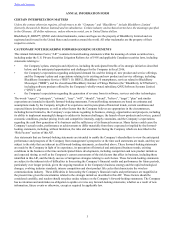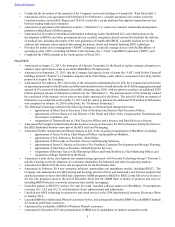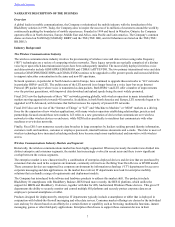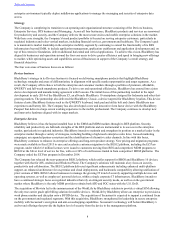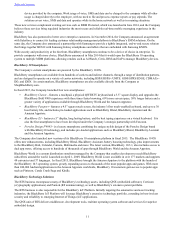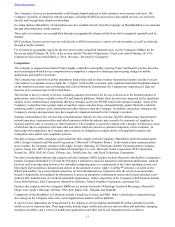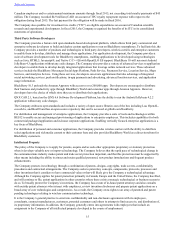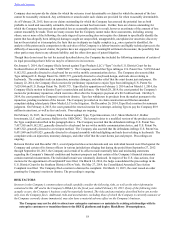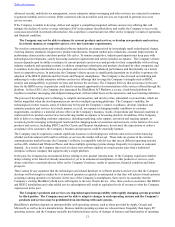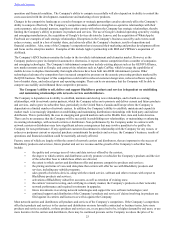Blackberry 2015 Annual Report Download - page 22
Download and view the complete annual report
Please find page 22 of the 2015 Blackberry annual report below. You can navigate through the pages in the report by either clicking on the pages listed below, or by using the keyword search tool below to find specific information within the annual report.
Table of Contents
13
The Company’s devices are predominantly sold through channel partners to both enterprise and consumer end users. The
Company’s portfolio of enterprise software products, including the BES12 and various value-added services, are sold both
directly and through these channel relationships.
In certain markets, BlackBerry 10 smartphones are also available directly from the Company on ShopBlackBerry.com, and also
through other third party online retailers.
These sales to customers are accomplished through a geographically-dispersed salesforce that is organized regionally and by
channel.
QNX products, licenses and services are sold directly to OEM customers in a variety of vertical markets, as well as indirectly
through a reseller channel.
For revenues by geographic region for the two most recently completed financial years, see the Company's MD&A for the
fiscal year ended February 28, 2015, in the section entitled “Results of Operations - Fiscal year ended February 28, 2015
compared to fiscal year ended March 1, 2014 - Revenue - Revenue by Geography.”
Competition
The Company is engaged in an industry that is highly competitive and rapidly evolving. Faster and broader wireless networks
and increasingly powerful device components have supported a competitive landscape and on-going changes to mobile
applications and mobile ecosystems.
The Company has seen both its global smartphone market share and its share in many international markets decline in recent
years relative to companies such as Apple Inc. (“Apple”) with its iOS ecosystem, and companies that build smartphones based
on the Android ecosystem, such as Samsung and Lenovo/Motorola. In particular, the Company has experienced a large net
decrease in its customer base in the United States.
This decline is due to a variety of factors, including consumer preferences for devices with access to the broadest number of
applications, such as those available in the iOS and Android platforms. Market share has also been impacted by the significant
number of new Android based competitors that have emerged, and by the BYOD trend in the enterprise market. Some of the
Company’s competitors have greater name recognition, larger customer bases, and significantly greater financial, technical,
marketing, public relations, sales, distribution and other resources than the Company. In addition, uncertainty relating to the
Company's strategy and operations may have negatively impacted demand for the Company's products.
Strategic relationships in the wireless data communications industry are also evolving. Specific infrastructure manufacturers,
network operators, content providers and other businesses within the industry may currently be customers of, suppliers to,
strategic partners with, or investors in, other businesses. The Company is currently working with a number of businesses, some
of which are direct competitors with each other and others which are current or potential competitors of the Company. In
interacting with competitors, the Company takes seriously its obligation to comply strictly with applicable antitrust and
competition laws and its own compliance policies.
Providers of major mobile operating system platforms that compete with the Company’s BlackBerry platform include Apple
(iOS), Google (Android) and Microsoft Corporation (“Microsoft”) (Windows Phone). In the wireless data communications
access market, the Company competes with: Apple, Google, Samsung, LG Electronics Mobile Communications Company,
Lenovo Group Ltd., HTC Corporation, Huawei Technologies Co., Ltd., Microsoft, Nokia Corporation, ZTE Corporation,
Xiaomi Inc., IBM, SAP AG, Citrix, VMware, Inc., Mobile Iron, Inc., and Good Technology Corporation.
Providers of embedded software that compete with the Company's QNX business include Microsoft, which offers a competitive
product (Compact Embedded or CE) and the Windows 8 Automotive stack for automotive infotainment applications. Android
has been used as an operating system in the embedded computing space as a replacement to the Linux operating system, and
both Apple and Google have demonstrated interest in the automotive sector. Apple’s CarPlay™ software is resident on the
iPhone and enables, via a wired digital connection, its own infotainment user experience onto the screen in an automobile.
Google’s Android has been adapted by third parties to power an automotive infotainment system and Google launched a new
Android API, Android Auto, for Android automobile applications. Other competitors of the Company's QNX business include
Green Hills Software, Intel Corporation, MontaVista Software, Mentor Graphics Corporation, and Sysgo AG.
Products that compete with the Company's BBM service include Facebook's WhatsApp, Facebook Messenger, Microsoft's
Skype, Line, Apple's iMessage, WeChat, Viber, Kik, Kakao Talk, Telegram and Snapchat.
Competitors of the BlackBerry IoT platform include Cumulocity, Exosite, and IBM. Other vertical player competitors may
also emerge as the Company enters new vertical applications markets with its platform.
A variety of new approaches are being pursued in the industry as diverse handset and handheld vendors attempt to provide
mobile access to corporate data. These approaches include larger mobile data devices such as tablets and netbooks, emerging
enterprise wearables, and a variety of middleware applications and other end-to-end integrated wireless solutions.


